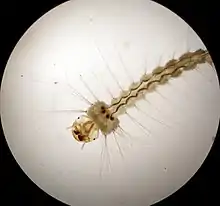Wyeomyia
Wyeomyia is a genus of mosquitoes first described in 1901 by Frederick Vincent Theobald.[2] The genus's 140 species can be difficult to characterize because of their diversity and the need for additional taxonomic work to further delineate them.[2] Adults resemble genus Limatus and Sabethes mosquitoes more closely than other genera in the New World tribe Sabethini,[2] but differ by their scutal scales ranging in color from a relatively dull bronzy with a slight metallic sheen in most species, to a metallic gold.[2] There are other distinguishing characters as well.[2][1][3]
| Wyeomyia | |
|---|---|
 | |
| Wyeomyia smithii | |
| Scientific classification | |
| Kingdom: | |
| Phylum: | |
| Class: | |
| Order: | |
| Family: | |
| Subfamily: | |
| Tribe: | Sabethini |
| Genus: | Wyeomyia F. V. Theobald, 1901 |
| Type species | |
| Wyeomyia grayii F. V. Theobald, 1901[1] | |
| Species | |
|
Wyeomyia medioalbipes | |
Distribution
Wyeomyia mosquitoes are predominantly neotropical, ranging across the Caribbean into Florida, with one species occurring in eastern North America.[1][2][3]
Ecology
Most Wyeomyia mosquitoes are forest-inhabiting, preferring damp environments.[1] Larvae develop in small collections of water in bromeliads and aroids, flower bracts, broken bamboo and bamboo stumps, tree holes, pitcher plants, and sometimes man-made containers.[1] They feed on organic matter in the water, including decomposing carcasses of insects and spiders.[3] Some species obtain oxygen directly from the water, rarely, if ever, surfacing.[3]
Adults are active during the day, usually near larval habitats.[1] Some species are found at characteristic elevations in the forest canopy, with others appearing to be restricted to ground level.[1]
Most Wyeomyia species will take blood meals, and females readily feed on humans who enter their habitat.[1] Although Ilhéus, Venezuelan equine encephalitis and Maguari viruses have been isolated from Wyeomyia mosquitoes, they are not known to transmit a disease agent to humans.[1]
Subgenera
The following subgenera are recognised:[1]
- Antunesmyia Lane & Cerqueira, 1942
- Caenomyiella Harbach & Peyton, 1990
- Cruzmyia Lane & Cerqueira, 1942
- Decamyia Dyar, 1919
- Dendromyia Theobald, 1903
- Dodecamyia Dyar, 1918
- Exallomyia Harbach & Peyton, 1992
- Hystatomyia Dyar, 1919
- Menolepis Lutz, 1905
- Miamyia Dyar, 1919
- Nunezia Dyar, 1928
- Phoniomyia Theobald, 1903
- Prosopolepis Lutz, 1905
- Spilonympha Motta & Lourenço-de-Oliveira, 2005
- Triamyia Dyar, 1919
- Wyeomyia Theobald, 1901
- Zinzala Zavortink, 1986
See also
References
- Walter Reed Biosystematics Unit: "Culicidae » Culicinae » Sabethini » Wyeomyia" in Systematic Catalog of Culicidae, http://www.wrbu.org/mqID/mq_gnra/wyeomyia.htm, accessed August 5, 2017.
- Mosquito Taxonomic Inventory: Wyeomyia Theobald, 1901, http://mosquito-taxonomic-inventory.info/simpletaxonomy/term/6251, accessed August 5, 2017.
- Robin McLeod with additional contributions by V. Belov: Genus Wyeomyia, Bugguide, http://bugguide.net/node/view/38485, last updated 11 October 2011, last accessed August 5, 2017.